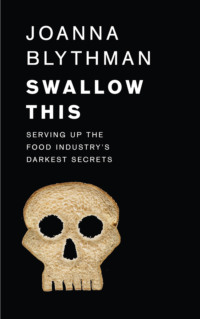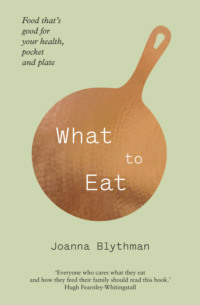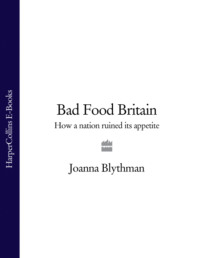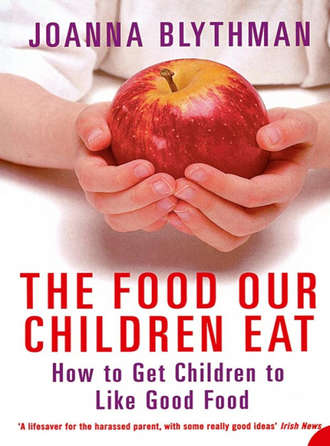
Полная версия
The Food Our Children Eat: How to Get Children to Like Good Food

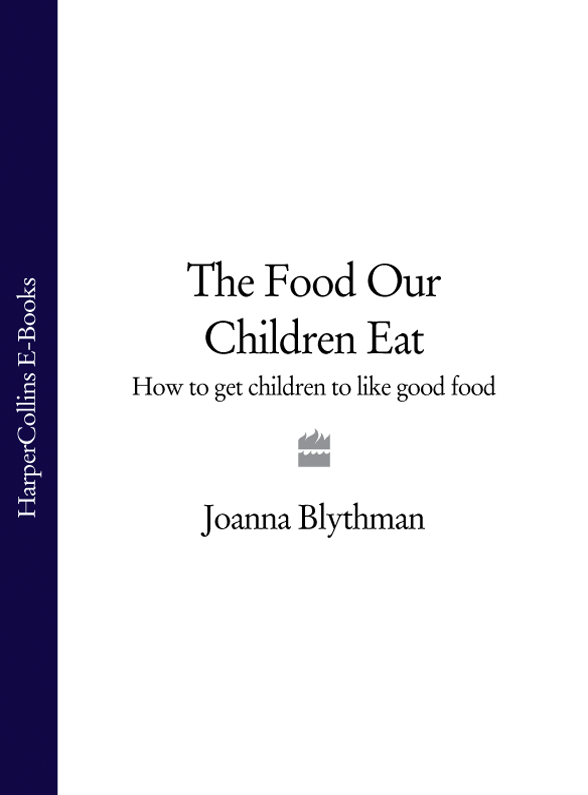
THE FOOD OUR
CHILDREN EAT
How to Get Children to Like Good Food
Joanna Blythman

CONTENTS
Cover
Title Page
A few pages to read first
PART ONE: THE GHETTO OF ‘CHILDREN’S FOOD’
The modern ‘children’s diet’
‘Picky-eater’ culture
Parents’ attitudes
The rot begins with those little jars
Staggered eating
Sweets as food
Crisp crazy
The flickering screen
Gift-wrapped junk
Goodbye dinner lady, hello cash cafeteria
Child (un)friendly restaurants
PART TWO: BREAKING THE MOULD AT HOME
The real-food approach
Getting the message across
Spending priorities
The ‘tunnel effect’ and how to prevent it
Eating together and why it matters
The ‘never-satisfied’ snacker
Don’t keep food you don’t want children to eat
Presentation, boredom and the ‘yuck’ reaction
Sweets, treats and bans
Good food that children like
What children should drink
Healthier look-alike alternatives to common ‘children’s foods’
PART THREE: THE GENTLE ART OF PERSUASION
Dealing with children who say no
Avoiding the same old mistakes
Setting up a cooperative food relationship
Refining objections to food
Serving up praise by the bucketload
Making mealtimes work
The scope for insistence
Giving in gracefully but …
PART FOUR: GETTING IT RIGHT WITH BABIES AND TODDLERS
You know best
The essential blender
Introducing the world of food
Pesticide residue risks and the organic alternative
PART FIVE: INFLUENCING WHAT CHILDREN EAT WHEN YOU’RE NOT THERE
What you can expect from childcarers
Negotiating with nurseries and playgroups
The friend’s house
School food
PART SIX: TESTING SITUATIONS
Shopping tips
Car trips
Birthday parties
Grandparents’ houses
PART SEVEN: CONSOLIDATING YOUR EFFORTS
Encouraging children to cook
The fun and skill of food shopping
The fascinating world of restaurant food
Exercising junior tastebuds
PART EIGHT: NITTY-GRITTY IDEAS AND RECIPES FOR INSPIRATION
Twenty-five good snacks
Ten main courses that both adults and children like
Ten good drinks
Ten good packed lunches
Ten ways to get children to eat vegetables
Ten ideas for making eating more fun
Ten easy recipes that children can make
Appendix: Checklist of Additives to Avoid
Index
Acknowledgements
About the Author
Other Works
Copyright
About the Publisher
A FEW PAGES TO READ FIRST
This is a book for people who want their children to become adults with wide-ranging food tastes, adults who select a good diet for themselves and find pleasure in the process of eating.
Achieving such an outcome ought to be a straightforward matter, but these days children who fit this bill are something of an endangered species. Children no longer eat what adults eat. We now live in a world that assumes children must be catered for separately, from a repertoire of special ‘children’s foods’ designed to please their distinctive palate.
In the new millennium, perhaps sociologists and social historians will look back on the second half of the twentieth century and point to the emergence of this separate diet as a curious phenomenon. When you stop to think about it, it’s a huge watershed. For centuries children all over the world have been brought up to eat what their parents ate.
Traditionally, children’s food has always been inextricably linked with adult diet, right from day one. Children were breastfed – even if that meant finding a wet nurse.
Graduating on to more complex foods, they were fed ground-down, pulverised versions of what the extended family was eating. As soon as they had teeth and had become more independent, they ate whatever was produced in the kitchen in whatever form it emerged.
Now in many industrialised countries, and in the UK in particular, it’s more likely that children are tucking into a restricted number of specifically ‘children’s foods’. We are all too familiar with them. The working title ‘junk’ fits them as well as any other. But if we wanted to analyse that loaded term a little further, we might describe it as consisting of a small selection of highly processed, long-life foods – many technological interventions removed from their raw-food roots – heavily loaded with fat, sugar and salt.
Enter the ‘modern’ child and a typical food day. This might start with a bowl of highly refined cereal stuck together with sugar in one form or another, followed by a sweet drink and a packet of crisps for morning snack. Chips and custard might be the most popular canteen choice at lunchtime, or a protein and fat-based, vegetable-free sandwich in the lunch box, accompanied by sweets, a token apple (if you’re lucky) and often yet another packet of crisps. In the starving after-school interval, biscuits and more crisps fill the gap until an early ‘children’s teatime’, when out come the frozen Kievs, fish fingers, pizzas and burgers, destined to be scoffed with chips and copious amounts of ketchup and washed down by something sweet and fizzy. For pudding, there’s the sickly-sweet ‘kiddie’ yogurt with its lovable cartoon characters and child-friendly synthetic flavours. Not surprisingly, by bedtime they’re hungry again and it’s time for supper. That packet of cereal beckons once more, as do the biscuits.
The consequences of this change in our attitude towards child nutrition are so enormous that they are hard to grasp. We are embarked on an experiment with our children’s health that is unprecedented. This is a radical departure from the tried and tested way of nourishing children that societies have adopted since history began.
You don’t have to be a paediatrician to figure out that this sort of eating defies the laws of nutrition. Nearly every item has been processed out of its natural form. It is top-heavy on ingredients we know cause health problems long-term and notoriously short on those that keep the human body healthy: whole, unprocessed plant foods, especially fruit and vegetables. So we are living through a strange irony. Instead of being given the best food available, as they ought to be, children are being given the worst.
It is going to take time for the impact of this major change in eating patterns to show through but initial indications are not good. Worrying tales have emerged from the US, where doctors have been shocked by the premature furring up of arteries that has inadvertently come to light when children have been admitted to hospital as road casualties.
Teachers complain that their pupils’ concentration span is not what it should be because they are going from one quick sugary snack to another and simply don’t have the stamina that a long, slow release of nutrients from a balanced diet would give them. According to the World Health Organisation, ‘The prevalence of overweight and obesity is increasing worldwide at an alarming rate … Moreover, as the problem appears to be increasing rapidly in children as well as adults, the truth health consequences may only become fully apparent in the distant future.’
Knowing how far this modern children’s diet is from any concept of good food, let alone healthy eating, an outside observer might assume that it is the prerogative of a poor and disadvantaged underclass that can’t afford to feed its children properly. But junk food is the great leveller. These days children from affluent backgrounds often eat as badly as their less privileged counterparts. The nation’s youth, it seems, is united in its attachment to junk.
Many parents recognise that they are not feeding their children the way they themselves were fed when young and they worry about this. But our anxieties are soothed by the overwhelming cynicism that surrounds the whole subject of feeding children. The fact that most children in the U K eat extremely badly has become institutionalised. Though new parents set out with good intentions, puréeing wholesome foods and vowing to be different, there’s a prevalent feeling that it’s only a matter of time till children graduate on to the modern crisps-and-cola, burgers-and-turkey-nugget repertoire. After all, they encounter it everywhere – at school, at friends’ houses, at the corner shop, on television.
The pressure on children to eat junk is so strong and so widespread that many parents simply throw in the towel. Why fight the inevitable, especially when no one else seems to be bothered? And there’s succour to be had from the feeling of safety in numbers, too. If all those freezer cabinets are full of pre-fried, re-formed bits of cheap animal protein targeted at children, surely they can’t be too bad? If the neighbourhood créche recommends crisps as a morning snack because fruit makes too much mess, who are we to stick out our necks and say differently? So many children live on this typical ‘children’s diet’ that surely it must be the norm?
Thus we live in hope that sooner or later, as though by magic, our offspring will be transformed miraculously into sensible adults with wide-ranging, sophisticated food tastes. We fondly imagine that burger-and-biscuit-addicted Kevin or Holly will turn into a marvellous eighteen-year-old who adores spinach salad, or stir-fried squid, aubergine and anchovies.
If you find those rationalisations comforting, then you may not want to read on. This book is for people who have the gut reaction that, however ubiquitous and common it might have become, the typical children’s diet is unacceptable. First, because it drastically limits children’s food horizons and therefore their ability to get pleasure from the delicious diversity of foods available, not to mention the sociable rituals that surround eating. Second, because it deviates so much from any notion of good nutrition that it stores up problems for their long-term health.
The core is that we need separate and different children’s food about as badly as we need a fatal illness. Instead, we should abandon the whole concept and reintegrate children into mainstream eating.
The ideas and strategies in this book are designed to help parents who want their children to eat better and who are prepared to put some effort into achieving that goal. The basic approach can work with children of all ages, even those who have already become accustomed to eating the typical children’s junk food. It is based on my knowledge as a specialist food journalist and my experience as a parent. The first has given me the conviction that we cannot afford to be passive about children’s junk because it amounts to a modern brand of malnutrition. The second has shown me that children can come to appreciate and actively desire a wide range of good, wholesome unprocessed food if the adults who feed them are committed to that idea.
My children, aged fourteen and ten, do not eat absolutely everything that I might as an adult, but they will eat, or at least try, most things. They have their likes and dislikes, as do adults. Mushrooms and aubergine get the joint thumbs-down. One refuses tomatoes but adores avocado; the other leaves the avocado and wolfs down the tomatoes. Nevertheless, they both eat a wide range of different foods from all food groups and there are no complete categories of food – such as vegetables – that are no-go areas. What pleases me most is that they actively enjoy eating. Meals aren’t just a refuelling exercise. They are enthusiastic eaters who approach even new foods with a positive and open attitude.
Some people wonder how they came to be this way. ‘What did you do with them?’ they ask. ‘Mine won’t eat that way, your kids are different,’ they remark. It’s an interesting cultural shift to see how children who eat reasonably widely and well have become the exception rather than the rule.
The answer is that there is absolutely nothing complicated, or even particularly demanding, about producing children who eat well. I have done nothing with my children that hasn’t already been done by generations of parents. The approach amounts to little more than common sense. It is just that these days, children’s junk food is so prevalent that parents think that the old laws of nutrition no longer apply. We need to be reminded of them.
So this book offers a common-sense strategy for getting children to eat better – one that also makes the job of feeding children easier, not harder. There are workable and effective strategies for every testing situation but, in essence, the approach is terribly simple.
HOW TO GET YOUR CHILDREN TO EAT WELL
• Feed children the same food you yourself eat.
• Socialise children into good eating habits by eating with them as much as you possibly can.
• Consciously open up children’s food horizons by introducing them to a wide range of tastes.
• Keep on presenting them with a wide range of foods even if they resist them at first: they will learn to like what they are given.
• Give them the freshest, most nutritious and best-quality food you possibly can.
This is the opposite of how many modern children eat.
HOW TO GET YOUR CHILDREN TO EAT BADLY
• Give them different food from that which you yourself eat.
• Feed them separately most of the time.
• Stereotype them as having narrow food horizons and therefore offer them only a limited number of foods.
• When they reject a food, do not offer it to them again consistently.
• Give them the most processed, least satisfying and least nutritious food around, otherwise known as ‘children’s food’.
The underlying assumption in the points above is that there is only one kind of food suitable for children – good food – and that the best way to deliver that is to socialise them into adult eating patterns and tastes from the time they are weaned. I firmly believe that the modern idea of separate children’s food, which assumes that children have different requirements from adults, is the enemy of good eating in the long term. By going down that ‘separate’ and ‘different’ road, food manufacturers have got away with transforming children’s food into a junk-food ghetto.
For this reason, I have deviated from other children’s eating guides by not including recipes for separate ‘children’s’ dishes. This book does, however, include recipes and meal ideas that should appeal to both adults and children alike; to my mind this is much more useful. It seems to me that children need to, and can, eat the same as everyone else.
Why? Because it’s much less time-consuming for the person preparing the food if there is just one meal on the go. Who can dream up and prepare two different sets of good meals each day for any length of time? If you adopt this way of doing things, then something has to give. What happens more often than not is that one ‘real’ meal is prepared for the adults and the children end up with reheated processed junk. So it seems to me that if we want children to eat well in the long run, we need to get them accustomed to eating the same as everyone else as early as possible rather than feeding them differently.
This book also asks you to question the modern habit of feeding children on their own, not alongside adults at communal mealtimes. If we accept that children need ultimately to pick up eating patterns that will stand them in good stead for the rest of their lives, the quickest and most effortless way to achieve that is for them to share mealtimes with adults as often as possible. I am not saying that it is impossible for children to learn to eat well when they are eating on their own, just that it is considerably more difficult.
These days, as I discovered in the process of researching and writing this book, any insistence on some commitment – however small – to communal household eating is controversial. Although many parents want their children to eat well in the long term, in the short term they find it easier and more practical to feed them earlier and apart. Modern lifestyles have changed. The nuclear family no longer sits down around the table at five o’clock.
Please believe that, as a parent who has always worked, I am not suggesting we turn the clock back to the ‘good old days’ when Mummy was perpetually in the kitchen baking and didn’t go out to work. I do not want any parent – male or female – to feel a failure or traumatised with guilt because they do not bake their own bread or make their own pasta in the frantic ‘happy hour’ after they get in from work and attempt to deal with everything from seven-times tables to endlessly ringing phones. But I do still think that, although communal mealtimes may not be possible every day of the week, even if you can manage it some nights and not others it will help socialise children into liking and appreciating a wide variety of good food and provide an important model for eating which challenges the pressure to eat junk.
So, while advocating communal eating as the goal to try for, this book also recognises the stresses faced by busy, modern parents and offers practical strategies for making successful compromises. It offers a positive long-term philosophy which allows lots of room for individual variation, not a rigid set of rules which are broken at the first deviation from theory. Believe me, it is designed to make life easier for those looking after children, not harder.
You will notice that this book is not presented as a ‘healthy-eating’ manual for children. There are no recommendations to switch your kids on to skimmed milk, lower-fat crisps or diet yogurt, or to read nutrition labels or count calories.
Why? Obviously, one of the main reasons most parents want their children to eat better is that this will make them healthier, but if we are overly concerned with health there is a danger of becoming almost hung up about what we eat. We stop eating certain things because they are ‘bad’ for us and food becomes all about prohibitions and ‘what is good for you’. Even for adults, this type of thinking is a pleasure-killer and for children that feeling is more intense.
What’s more, this thinking is pointless because children can learn to enjoy fresh, wholesome, healthy food when it is presented to them in a positive way, mainly because it smells and tastes good in a way that junky children’s food never can. So the main rationale we give children for eating natural, wholesome food as opposed to junk has to be that it tastes better, not because it is ‘good for you’.
The concept of healthy eating is also much abused and often reinforces the paralysing modern notion that parents do not know how to feed their children any longer and so need help from ‘experts’ who provide ‘special foods’. But often these ‘experts’ are backed by powerful industry interests whose ‘advice’ is highly suspect. A lot of junk and heavily processed food these days can be presented as ‘healthy’ simply because it is low fat, despite the fact that it contains almost no useful nutrition. Thus a diet cola drink can actually come over as a healthy alternative to regular cola. But no cola drink has a place in any common-sense understanding of a wholesome diet.
The philosophy behind this book is that if you give your children food prepared from fresh raw materials in their natural, nutritious, unprocessed form, and encourage them to eat a wide selection of foods from all the major food groups, they will be eating healthily – end of story.
Most modern children do not eat this way. Their diet is top-heavy with protein, fat, refined carbohydrates, salt and sugar – a consequence of their dependence on processed foods. Their consumption of fresh fruit and vegetables is almost invariably far too low. ‘Eat more fresh fruit and vegetables’ is the one positive food message on which most nutritionists can agree and it’s the only modern health message on which parents really need to focus. So this book provides plenty of positive and effective strategies for getting children to like fruit and vegetables and increase their consumption of them.
But that is as far as conscious ‘healthy-eating’ guidance goes. The typical unbalanced children’s diet is a consequence of feeding children on a separate range of highly processed foods, which have been manufactured for profit rather than to retain their nutritional integrity. By drastically reducing the processed foods given to children and replacing them with wholesome unprocessed ones, parents can embrace healthy eating without getting embroiled in often-contradictory nutritional guidance.
So if you follow the real-food approach described in Part Two, you won’t get bogged down in whether that margarine has 15 or 50 per cent polyunsaturates. Instead, you’ll be concentrating on stimulating your children’s palate so that they enjoy a wide variety of fresh, unprocessed food, where pride of place is given to fruit and vegetables. If you do that, then you can afford to be laid-back about ‘healthy eating’.
This book is organised so readers can home in on the sections they find most useful. Part One examines the nature of the general problem we have on our hands now that so many children live on junk. You may find that it makes disquieting reading. Skip it, by all means, if you prefer, and move on to the rest of the book. Part Two, Breaking the Mould at Home, explains the general strategy for getting children to eat well. Part Three, The Gentle Art of Persuasion, is a troubleshooting section for when the general strategy doesn’t seem to work. Part Four explains how feeding babies can dovetail with this overall approach. Parts Five and Six offer practical strategies for sticky situations. Part Seven suggests ways of reinforcing your efforts, while Part Eight offers ideas to inspire you when you can’t see beyond the difficulties.
This book is an empowering one which offers parents the conviction that over time, and with a little bit of commitment, you can produce children who actively enjoy good wholesome food. Such a goal is both desirable and attainable. It will strengthen your resolve to trust your own common sense and good judgement and to be different from the pack, but it will also arm you with devices to cope with the ‘real world’ challenges faced by parents who want their children to eat well.



